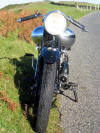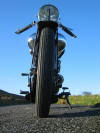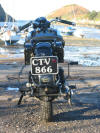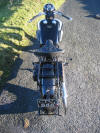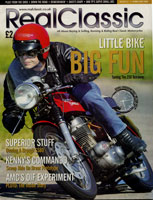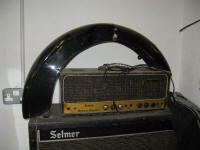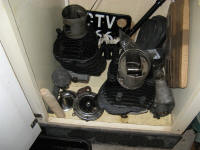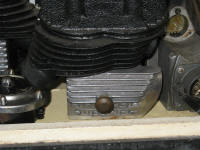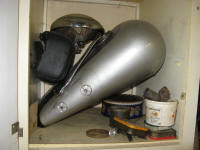|
|
|
| Marque | Brough Superior |
| Model | SS80 |
| Year | 1936 late season model |
| cc | 1000 |
| Engine | 4 stroke V-twin side valve |
| Starting | Kick |
| Gears | 4 (foot) |
| Top speed | 80mph |
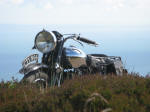
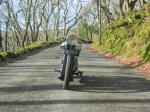
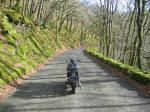
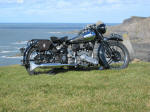
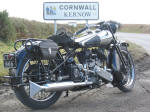

Here is the Brough with the pillion seat attached, which takes about 2 minutes to do.

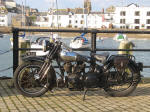
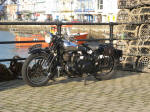
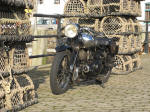
Road Test - Getting to grips...
Ever since I became aware of Bruffs,
I thought it would be nice to own one some day without thinking that I
ever would own one. The same goes for a long list of ‘big league’ bikes
that include a V-twin NUT, Series A HRD and cammy Chater Lea. They were
always beyond my reach and I admired them from a distance starting from
the age of about seventeen. Having entered my forties and sold my flat
not so long ago, I realised that for the first time in my life that if I
was prepared to be financially reckless, that I could have a Bruff.
I spoke to Darren Vickers who although relatively new to Bruffs, is
quite an expert and gave me the low down (thanks Darren). I realised
that there are few really good Bruffs that come up for sale and a
handful of overpriced dogs that a newcomer should avoid. The adverts in
the owners club magazine are sparse too, so I needed to read as much as
I could and be ready to pounce when the instinct called. The late 30s
Matchless powered side valve SS80 models are the cheapest and are also
known as the MX80 (OHV Matchless powered SS100 models are also known as
the MX100). The SS100 is generally considered to be the ultimate
connoisseur’s mount and was ridden most famously by T.E. Lawrence. He
often wrote poetically about them in letters to George Brough about how
he explored the English countryside and even raced against military
aircraft across the Southern English landscape (and beat them too -
according to T.E.). To Lawrence, the experience was spiritual and he
spent many hours each week riding Bruffs and having Bruff adventures.
With the decision made to enter the world of Bruffs, I found one (or it
found me if you like) that seemed to have the right credentials. Bruffs
were issued with a ‘works record card’ on completion at the factory in
Nottingham and these cards detail the components that were fitted to the
accompanying machine. This is especially useful as Bruffs were generally
made to customer specification, which means that each one is individual.
According to the ‘works record card’, mine is a late 1936 model and was
made with a set of Druid forks. The forks have been replaced by the
Brough ‘Castle’ forks which would have been a more expensive option.
These forks owe their design roots to the Harley Davidson and looking
over the machine there are other design points that were inspired from
across the pond, probably because when George Brough started to make his
own machines the Americans were leading the world in motorcycle design.
The deal was done, and I had to ride the SS80 about 350 miles from
Norwich to Exmoor. The weather reports were abysmal and chance was
going to play a role in getting me home. Looking around the bike, I
realised that probably because these bikes are so prized, they really
are looked after with no rounded fasteners or ham fisted fixes. I sat on
a Bruff for the first time ever and set off for my overnight stop in
London. First impressions were that the handlebars were very narrow and
that the wheelbase was very long. The engine ticked over nicely,
although the cold rear piston slapped as its cylinder had been overbored
to avoid seizure when hot.
The advance lever hardly needs any use and the big soft engine is very
comfortable to use. Out on the open road, the Bruff really comes into
its own with long legs and a very stable feeling in a straight line
regardless of wind buffeting and changing road surfaces. The rear brake
is good but the front brake is the only real Achilles heel that I’ve
found. It’s too soft and if there’s anything that I can do to improve
the machine, then it’s to find a way to get more bite from the front
anchor. I held 60mph for most of the way to London and the weather gods
were smiling. Cornering is different to what I’m used to. You need to
think more about corners in advance and drive the Bruff through without
changing the plan half way around. If you’re used to Nortons or other
smaller sports bikes, then you need to understand that the Bruff may not
be able to help you if you get the corner badly wrong. Also, the
footrests have end stops, which can trap the riders boot if the rear
brake (the only one that makes a difference) pedal needs to be found in
a hurry. This is not a problem once you understand the rules and I
really began to enjoy this high speed tourer with its big soft engine
and solid feel. This really is a gentleman’s mount. Apart from a little
mechanical whine there’s a lovely fat exhaust burble and that fine
cantering lollop of a big V-twin.
Somewhere on the A4 in Slough, the gear lever went floppy. The return
spring had broken and this meant that I needed to return the lever
manually when swapping cogs. The gear lever is very long and requires
thigh muscles rather than ankle muscles, but the Norton type dolls head
gearbox makes confident changes without any dragging or hesitation.
After a six hour ride from London to the far end of Exmoor, I was still
very comfortable! How can this be when there’s no rear suspension and a
semi sports position on the handlebars? I could have ridden all day.
Summing up, I’m thrilled with Bruff ownership and the grin is wide.
Everything works as well as it did in 1936 and I keep getting the urge
to go out for another ride. Life can now be divided into Pre and Post
Bruff periods and I wonder how I’ve survived all these years without
one. It’s a shame that I had to wait all these years to own one, but the
best things are worth waiting for and this is a best thing. If the SS100
is the ultimate connoisseur’s mount, then the SS80 must be the ultimate
gentleman’s mount.






